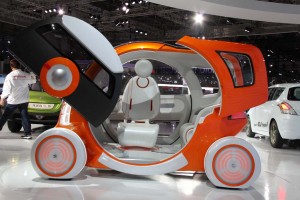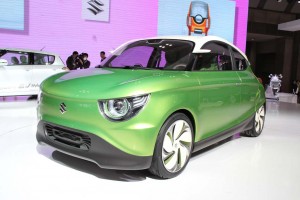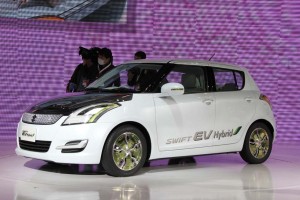The 2011 downsized Tokyo Motor Show may not have the grandeur of years past but thanks to Suzuki tradition remains alive.
The biennial event has long been known for bringing us some of the wildest-weirdest and wackiest concept vehicles – and that’s about the best way you can describe the three concepts brought to the show by Suzuki as part of its corporate theme, “Small cars for a big future.”
That notably includes the Q-Concept, which company officials described as “ideal for everyday journeys within a radius of about six miles,” during the makers Tokyo Motor Show news conference.
Its bright orange body would likely look more appropriate in a Japanese manga comic strip than on the streets of modern-day Tokyo, the split two-piece doors opening up like a children’s toy to give it a distinctive, Q-like shape. The interior, meanwhile, can be outfitted with a single, rotating front seat and used for, say, pizza – or sushi? – deliveries, or two child-sized seats can be added in the rear.
Like the other Suzuki show cars, the Q-Concept is designed to minimize a motorist’s environmental footprint, here by running on battery power.
The Regina is a micro-sized world car that would stick to gasoline power but match the efficiency of even the best hybrids. Regina has a sort of retro-futuristic look, its exaggerated shape reminding some observers of the Nissan “Pike” cars of the 1980s, which included the Figaro and the appropriately named, snail-shaped Nissan S-Cargo.
But the design isn’t entirely for show.
Weighing in at barely 1600 pounds, it features a design that Suzuki claims is at least 10% most aerodynamic than the current, production Regina. That helps the Regina concept deliver an astounding 88 mpg fuel economy in the Japanese test cycle.
The most traditional-looking of the three Suzuki show cars is the Swift EV hybrid, which relies on a range-extender driveline similar to what’s used in the Chevrolet Volt. It can get an estimated 12 to 18 miles per charge on battery power then shift over to its small internal combustion engine. But the gasoline-powered side of the driveline only serves as a generator and can’t be used to directly drive the Swift EV’s wheels.



